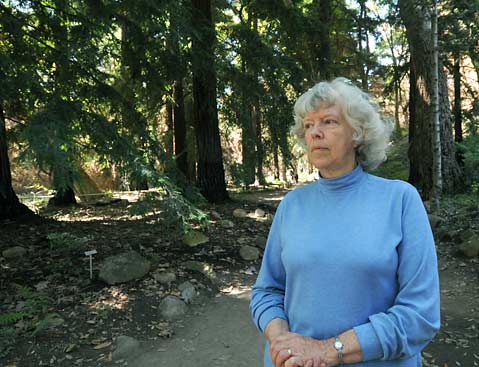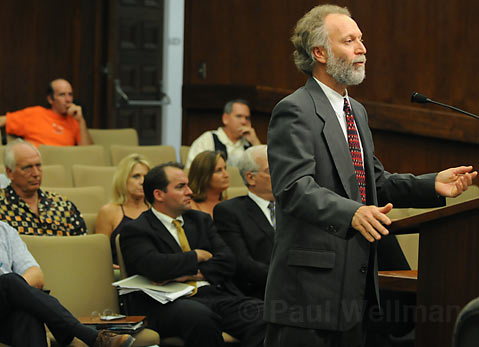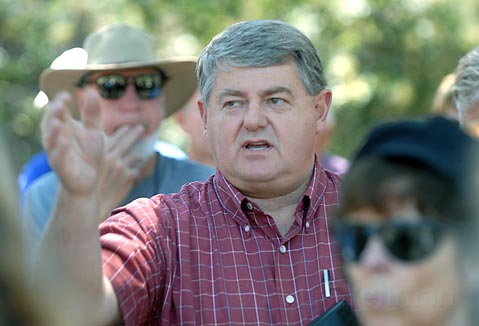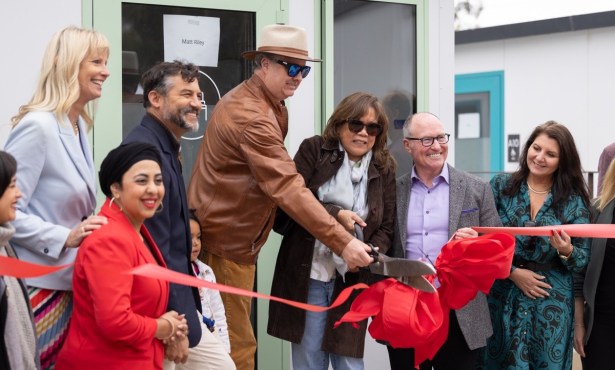How Our Botanic Garden Grows
Current Leadership Yearns for Facilities, But Many Aren't Pleased

Deep inside the herbarium at the Santa Barbara Botanic Garden, Dieter Wilken is holding a specimen of Santa Cruz Island ironwood that’s glued to a piece of archive paper. He’s surrounded by rows of gray shelving units, home to the more than 150,000 similarly collected specimens that make the Garden one of the most important plant resources on the West Coast. But as Wilken carefully puts the ironwood away, his gaze shoots to the top of the cases, where countless stacks of specimens sit without a home, no longer able to fit on the jam-packed shelves. “The critical thing is that we have many specimens we can’t put in here,” said Wilken, vice president of programs and collections at the Garden, which was founded as a showcase for native California plants in 1926. “We’ve essentially run out of room.”
The lack of space for specimens is just one of the many arguments presented by the Garden’s administration as to why they’re pushing for more than 25,000 square feet of new development. Most of this would create room for conservation, research, and education; but it also includes more plant propagation areas, affordable housing for employees, fencing for 70 percent of the property, and about 700 square feet of “general support, additional visitor-serving and events facilities,” according to the project’s environmental impact report. Read the EIR summary yourself.
Of the 30 structures currently on the Garden’s 78 acres, six would be demolished, two would be moved, and 16 brand new ones would be added over the next 10 years. The strategically named “Vital Mission Plan” – which will also finalize controversial alterations to the Garden’s historic and landmark-protected meadow – goes to the County of Santa Barbara’s Planning Commission on Wednesday, August 5. Even after nearly four full years of tweaking and debate, it’s expected to be one of the more contentious issues for decision makers in the months to come.
“In a nutshell, we’re concerned that what the Garden is a proposing is simply out of scale with Mission Canyon,” said Marc Chytilo, the attorney representing Friends of Mission Canyon, a watchdog group concerned about fire safety, increased traffic, and other possible impacts. “They literally want a campus for researchers, for students, for their administrative staff, and for visitors,” argues Chytilo, who’s also a Garden neighbor. “While that’s a nice idea, it defies the constraints of Mission Canyon. They are on a single road in a box canyon, and they have no secondary means of access should the road be blocked by fire, flood, or anything else.”

Allied with concerned neighbors are history buffs and longtime Garden users such as Paulina Conn, who six years ago spearheaded the move to get 23 acres of the property – which were designed in 1938 by legendary landscape artist Lockwood de Forrest – declared a county historic landmark. “The curator of an art museum wouldn’t put a mustache on the Mona Lisa,” said Conn. “That’s what they’re doing to the Botanic Garden.” Conn believes that the changes to the meadow – which include putting pavers on dirt trails, and a terracing project that was stopped by county officials last year after considerable uproar – go against the historic vision and will destroy the aesthetics of the Garden forever. “They want to create something so commonplace out of something that was so visionary,” said Conn, who’s opposed to just about every part of the plan, from the new entry bridge across the arroyo section, and the children’s learning center replacing part of the manzanita garden, to the addition of a snack bar and elevators.
The Vital Mission Plan sounds a lot less frightening when described by the Garden administration. “The plan simply allows us to do what we do today better, not bigger,” said director Ed Schneider. He believes that without the plan, the Garden – which laid off several longtime staffers earlier this year, citing financial losses due to the economic recession – cannot fulfill its function. Earlier proposals were about growth, admitted Schneider, “yet this plan is simply about carrying out our mission of plant conservation, research, education, and display.”
To those who say he’s straying from the original vision, Schneider points to a 1927 mission statement, which states: “It is the aim of the Garden Committee to so unite the aesthetic, educational, and scientific that this Garden will hold a unique place in the horticultural world.” Schneider explained, “Our mission today is unchanged. Some like to think of the Garden as a private nature preserve or a neighborhood park, but this never has been our mission.” The substantial damage caused by the Jesusita Fire only makes the plan more imperative, said Schneider, due in large part to the loss of the four-story Gane House, which served as headquarters for many staffers and gardeners.
“We have added more and more open space to the Garden over the past seven decades,” he explained, “but not the facilities to care for them.” As part of the plan, the Garden officially adds 13 more acres – so although total development increases to about 65,000 square feet, buildings still only amount to one percent of the property, with 99 percent remaining open space. As to fears of more and bigger events, Schneider said that the plan actually puts a limit on events for the first time. “There will be neither more nor larger special events than in the past,” he promised.

The Garden currently attracts an average of about 305 people per day, with a growth of about one percent per year. As part of the plan, the Garden expects an additional 0.8 percent annual growth, which, by 2030, would amount to 415 average visitors per day. That increase sounds like a lot to Chytilo and his neighbors, and in any case, many of them simply don’t take Schneider at his word. Recalling a road project that the Garden completed about three years ago, Chytilo said that the administration had promised not to shut off Mission Canyon Road, but it happened anyway. “There was a real breach of trust there,” said Chytilo. “Fortunately there was no fire and no one died.”
Chytilo said he sat down with Schneider even before that incident and suggested that the Garden develop a plan everyone could support, but his advice was ignored. “When you are managing an organization like this, it’s really part of your responsibility:to maintain relations with their neighbors as well as with elected officials and the larger community,” said Chytilo. “They have rejected that concept, I think, and certainly rejected our overtures to work amicably and come up with something we could all support. They’ve intentionally put themselves into this very adversarial position.” Chytilo’s assessment echoes the critiques leveled by more than 60 volunteers who have been striking for months while demanding more transparency from both Schneider and the board of trustees, whom they accuse of enabling Schneider’s administration to mismanage the Garden.
Chytilo claims to be “sympathetic” to the Garden’s need to remain financially viable and attract guests, though he suggests that the Garden move some activities elsewhere. He recommended that the Garden institute a lecture facility downtown, and that it house all its administrative operations in the new Gane House. “There’s definitely a good case to be made for some renovations and remodeling,” said Chytilo. “But you don’t need to tear everything down and start brand new. They could take a much more modest approach.”
Chytilo, according to Schneider, represents a breed of neighbor who will remain opposed to anything and everything the Garden proposes, even after nearly 10 years of talks. “We have now eliminated every thing we can eliminate,” said Schneider, who believes that “being a good neighbor goes both ways” and that those who remain opposed “have not appreciated or even understood our need for the very basic plan we propose today.” Schneider was hoping for more give and take. “We have given and given,” said Schneider, “and those who remain opposed have taken and taken.”
In any case, the givers, takers, and everyone else seem to believe that the August 5 meeting won’t be the last. The presentation itself may require more than one Planning Commission hearing, and whatever happens, each side is so entrenched that an appeal to the Board of Supervisors is more than likely.


